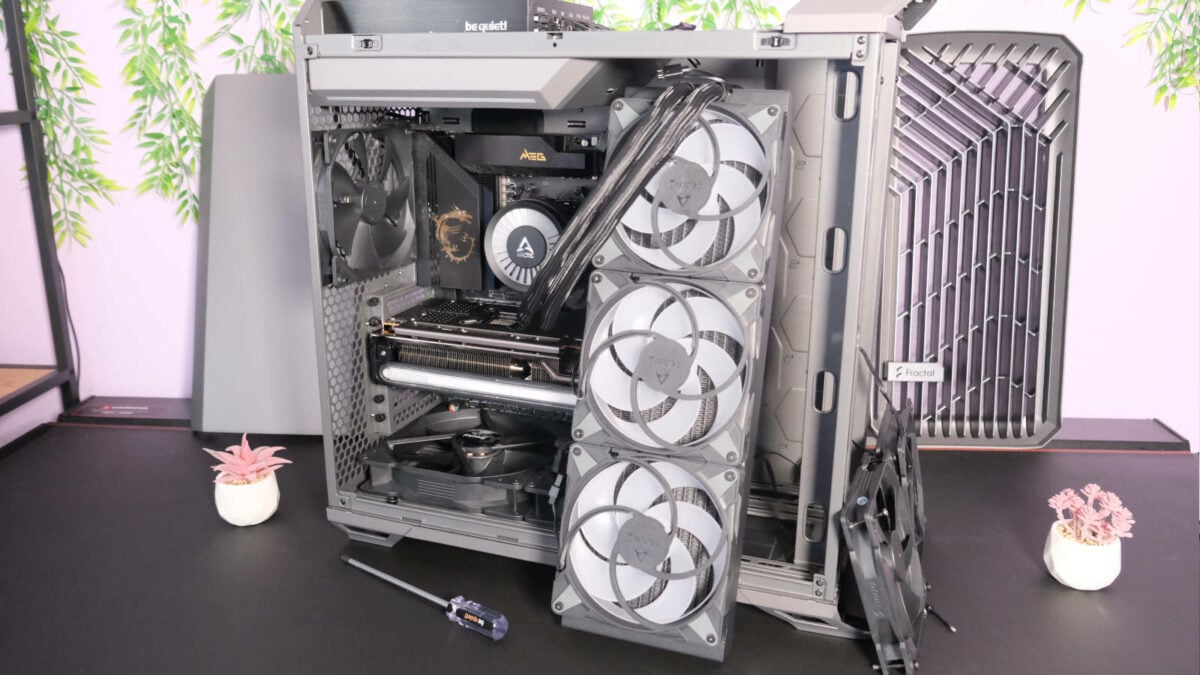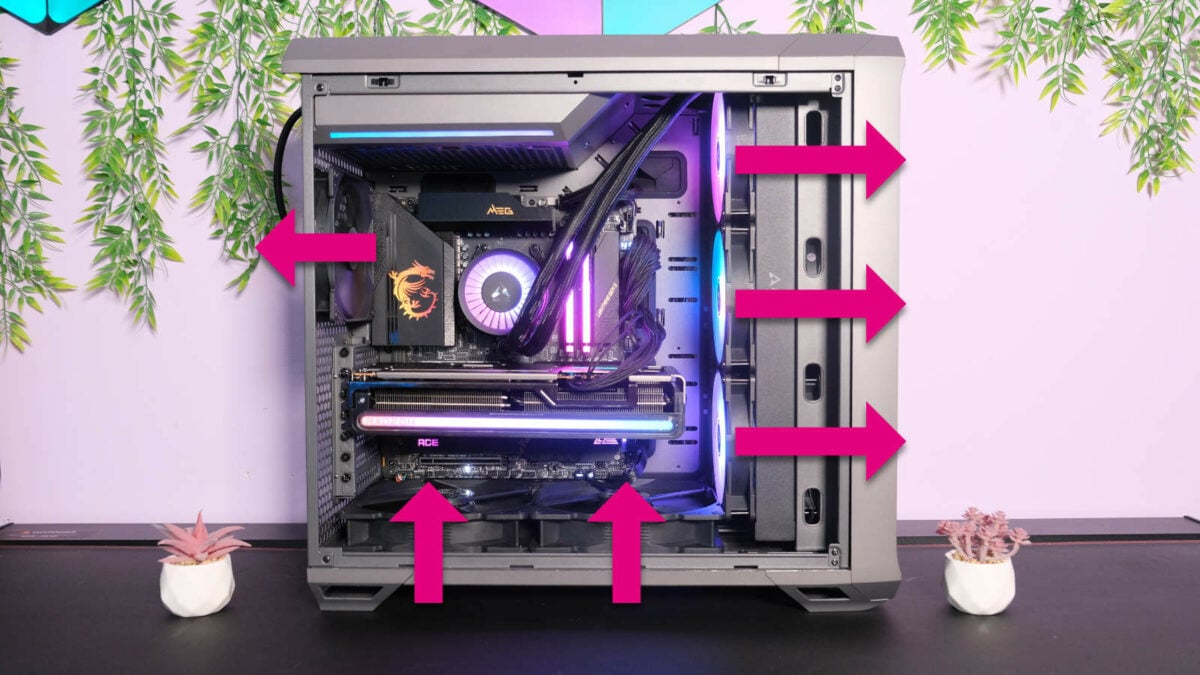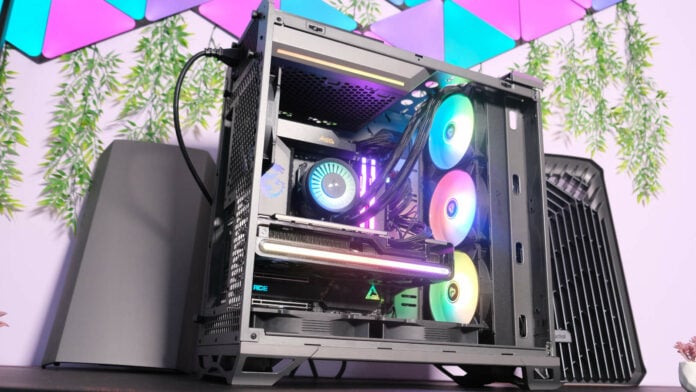With a new year comes the need for a new test bench so we can put reviews through their paces. It’s not good enough to just think about what components to include, but how to keep them running smoothly. This comes down to the age-old debate of airflow pressure. How much of a difference can your fan configuration truly make?
My initial instinct is almost always to go with a positive airflow. This is where you have more air coming in than out due to more, bigger, or simply better intake fans. The excess air finds its way out of perforations in the case, which is fantastic for keeping dust under control. On a personal PC, it helps you spend less time spring cleaning so you can get back into the game.
However, cleanliness is the least of our worries when we’re always swapping parts in and out. What’s important to us are low temperatures to keep performance running high and aesthetics so everything looks top-notch. That’s why we tinkered with just about everything we could with our new build. Well, that and the fact compatibility demands a sacrifice.

The process
Using a Fractal Torrent PC case, we were already covered for most of the fans. Two 180mm Fractal Dynamic GP-18 fans sit at the front, and three 140mm Fractal Dynamic X2 GP-14 fans lie at the bottom by default.
Our first hurdle came from our chosen CPU cooler, as the all-in-one is a bit of a chonk. You only need to take one look at our Arctic Liquid Freezer III 420 review to see why it’s our current favourite, but such a large radiator only fits in the front or bottom here. Since you always want the pump to sit lower than the highest point on the radiator to avoid air pockets, the front was our only real option.
Further complications arose when we decided to use a push-pull configuration, putting fans on either side of the radiator. Space constraints at the front meant we could only fit two 140mm fans on the outside rather than the ideal three. Still, sandwiching the radiator between five fans is plenty.
In the shake-up, we moved the 180mm blowers to the bottom, keeping them as intakes. There’s no way we’d give up their sweet sound of silence or their ability to hit up to 307.4CFM combined. The lone 140mm fan that wouldn’t fit at the front now acts as our rear exhaust.
It’s just a question of which way the fearsome five at the front should face. Three Arctic P14 PWM 140mm pushes 218.4CFM combined, while the single rear Fractal Dynamic X2 GP-14 PWM adds 105.9CFM for a total of 324.3CFM. Together, they dictate whether the system has a positive or negative airflow, so we need to know which is better.

The results
Pitting our AMD Ryzen 9 7950X3D CPU and Sapphire Radeon RX 7800 XT GPU against Cinebench 2024, there are only a couple of degrees between either config. Positive airflow shaves 2.5°C off our CPU temps but raises the GPU by 1.3°C. Why? Sherlock would call it elementary.
| Positive airflow | Negative airflow | |
|---|---|---|
| CPU temps | 64.4°C | 66.9°C |
| GPU temps | 64.7°C | 63.4°C |
Positive airflow helps AIO temperatures because it directs cool air from outside of the chassis through the radiator fins. In a negative airflow arrangement, it pulls slightly hotter air from inside the PC case, which isn’t as effective at chilling the liquid running through it. In our build, the pump has a built-in fan to keep the air moving near the socket even when less air passes through the chassis.
When it comes to the GPU, the absence of air in a negative system is a blessing. Simply put, it’s easier for the graphics card heatsink to expel heated air into a vacuum than it is to contend with more heated air from the CPU cooler, motherboard VRMs, and other components. Our choice even vents heat out the back, being a triple-slot card with an exhaust.
Regardless, it feels like splitting hairs. Despite the gloomy name, negative airflow isn’t bad. It can hinder the efficacy of air coolers since they rely on passing ventilation, but it doesn’t make a big difference to AIO coolers so long as the radiator’s high-pressure fans are up to the task. You just need to make sure your case has plenty of holes, like our Fractal Torrent, and whip out a can of compressed air a bit more often to keep on top of the dust.
Honestly, it’s a relief. There are a lot of small benefits to our negative setup aside from performance. Arctic P14 PWM A-RGB fans look far better with the lighting pointing inward. Cable management is also far neater than it otherwise would be. Temperatures are brilliant either way, letting us fix RPM to a meagre 30% for a whisper-quiet build without sacrificing performance. Not bad for the sake of a degree or two.

